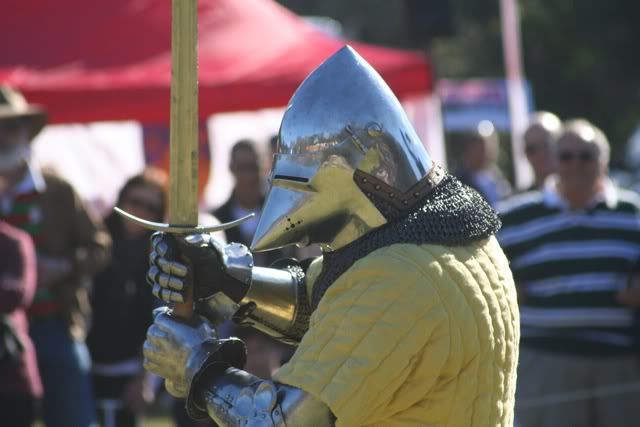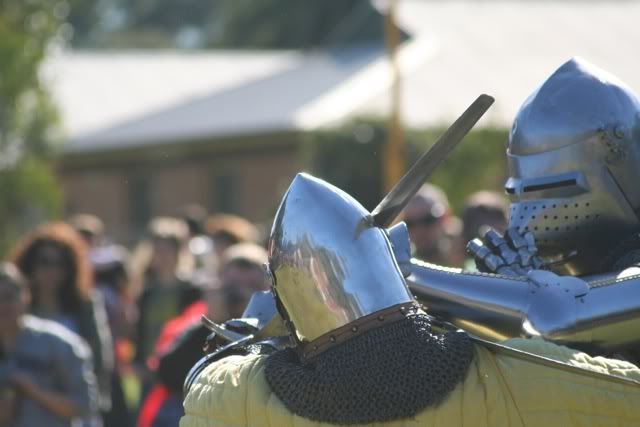Winterfest 2011
On July 2nd and 3rd, Company of the Staple was once again invited to attend the annual Winterfest show held at Parramatta Park.
A report of the great deeds of arms performed at Winterfest by the noble Order of the Heron, courtesy of Aldyn de Sutton (aka Elden):
Winterfest 2011
In the year of Grace, 2011, during the long reign of King Edward III, on feast of Peter and Paul, in the parish Matta, knights and squires of the Order of the Heron held hastiludes by the permission of the king in those fields. Three lords of the Company of the Staple at Calais, all meaning to journey to the distant lands of Abbeystowe to undertake great deeds of arms, had decided to travel together for their mutual improvement and good company on the road. That all would know them well, they bound their affinities into an Order of the Heron, dressed themselves in livery of gules and azure and prepared themselves for a long expedition to distant lands.
Making his own way to Abbeystowe through parish Matta was Sir James Stallard, knight of England and also Lady Emma of Pioch and Lady Lisa Farrell.
Lady Farrell with falcon.

Russell withstands the blow.
Hugh de Caleys then sought Sir James Stallard to lay three blows with longswords. Both fought gallantly, and with such furious intensity that two blows were quickly struck by de Caleys followed directly by one resounding blow by Sir Stallard. With all honour of the contest carried in the next blow laid, both launched sudden master strokes to each other with no regard for their own defense, and in the coincidence, struck each other dreadfully in the same moment and then fell back. With neither lords or the presiding herald able to rightly say which blow had struck first, the winner could not be decided and the honourable herald, John Locke, declared that with both men so shaken by the blows received that to preserve both gallant lords, the next stroke laid would in fact decide the victor. When both could again stand ready, it was Sir Stallard who first struck, and who triumphed of it.

Sir James Stallard
After brief respite could be made, lord de Sutton challenged lord de Caleys to lay blows with longswords until one was forced from the field. They swung stout blows in many gallant assaults until de Caleys, having struck his opponent many times with devastating effect, closed and deftly grappled the arm of de Sutton such that he was compelled to release his own sword and was driven disarmed to the ground and yielded.
At this time it was the pleasure of the noble spectators to view a tilting match in that field at parish Matta and so no more blows were struck on foot until the morrow. In concluding the valiant deeds of the day, Hugh de Caleys was given first place by the pure and honourable ladies, witness to the deeds, for his performance on the field.
first to be the victor.

James (left) takes a hit from Hugh (right).
Lord de Sutton then challenged Sir McKinnon to lay strokes with longswords until the victor may bear his fellow to the ground. As they laid resounding blows upon one another, Sir McKinnon’s fine belt of plaques was struck from his person. Finding no shame in it, Sir McKinnon rather bade his opponent do worse if he would seek to strike
him bodily.

Alyden (Left) and Andrew (Right) exchange blows
With more blows struck, Sir McKinnon closed on de Sutton seeking to throw him from his feet but, finding him as if an immovable hillside, was himself borne to the ground by de Sutton. As the herald called a victory, the lord de Sutton rose to declare that he himself
had met the ground with McKinnon, and that the result was indeed a tie. Moved by his humility, the ladies there declared that de Sutton was the champion of the second day.

Aldyn is heralded the victor
The deeds concluded, the lords withdrew to lodgings to pack and provision for the great journey to Abbeystowe and eagerly plan for the honourable challenges that lay ahead of them.
Winterfest 2009
The Company of the Staple proudly attended the Winterfest medieval fair again this year. As with last year, it was held over the middle weekend of the winter school holidays (18-19 July) at Marsden Park, N Ryde.
We had our little fourteenth century camp set up, demonstrating the sorts of clothes and shoes 14th Century people wore, what they would have eaten, and demonstrating various trades such as leather-working, chape-making, finger-braiding, weaving, and spinning. Also on display was a range of arms and armour, from the militiaman’s akerton coat, pot helm and spear to the knight’s shining armour and deadly longsword.
The highlights of the weekend were the jousting displays and the Full Flight birds of prey. Both were amazing to watch and really added to the overall atmosphere of the event.
Once again people came to experience the fair in even greater numbers, and the entertainment put on by the re-enactment community just gets better and better. We’re already looking forward to next year!
| From Winterfest 2009 |